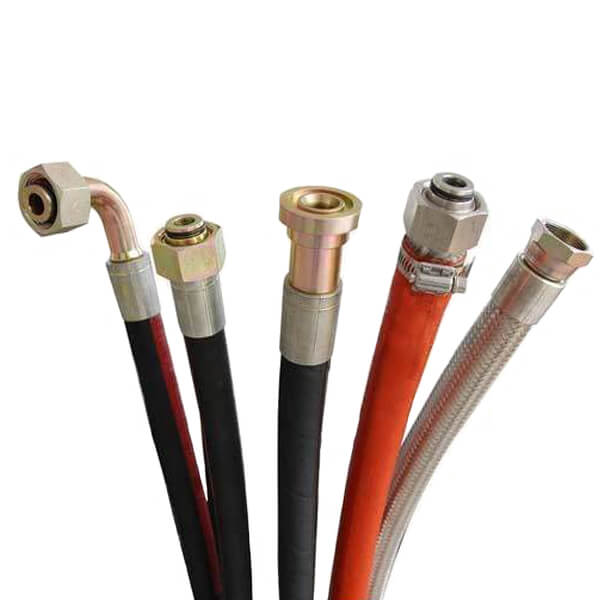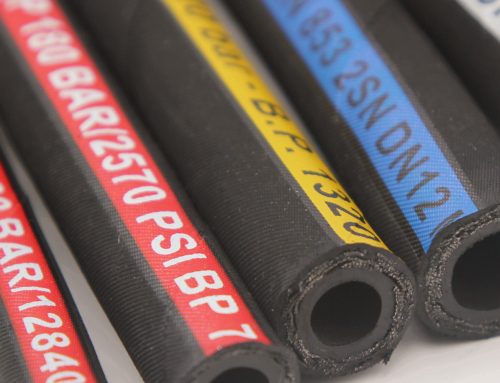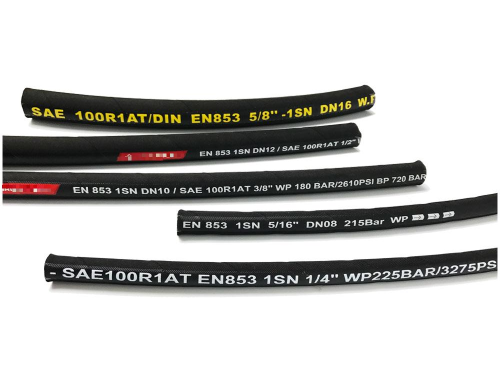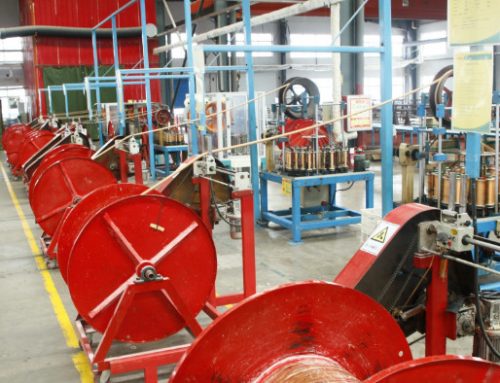What is Hydraulic Hose?
Hydraulic hose also called hydraulic oil hose, hydraulic rubber hose, high-pressure hose, hydraulic pipe, steel wire high-pressure hose, steel wire braided hose, steel wire spiral hose, generally divided into steel wire braided hydraulic hose and steel wire spiral hydraulic hose. The hydraulic hose is mainly composed of a liquid-resistant inner rubber tube, a middle rubber layer, from one to six layers of steel wire as reinforcement layer, and an outer rubber layer. The outer rubber layer protects the steel wire from damage, and the steel wire layer is the skeleton material for reinforcement.
Medium Temperature
Oil – 40’C degrees to +100’C degrees; Air – 30’C degrees to +50’C degrees;
Medium
Carry out hydraulic power transmission or transport high-pressure media such as water, gas, oil, etc., to ensure the circulation of liquids and transfer liquid energy.
Executive standard
The standards often used in domestic and foreign trade of hydraulic hoses include DIN, SAE, ISO and GB/T standards;
The standards for steel wire braided hydraulic hoses are: DIN EN 853, SAE J517, GB/T 3683-2011, ISO1436;
The standards for wire spiral hydraulic hoses are: DIN EN 856, SAE J517, GB/T 10544-2003, ISO3862
Features
1. The hose is made of special synthetic rubber, which has excellent oil resistance, heat resistance and weather resistance.
2. The tube body is tightly combined, soft to use, and less deformed under pressure.
3. The hose has excellent bending resistance and fatigue resistance.
4. The hose has high bearing pressure and excellent pulse performance.
Useage
The products are mainly used for mine hydraulic support, oil field mining, suitable for engineering construction, lifting and transportation, metallurgical forging, mining equipment, ships, injection molding machinery, agricultural machinery, various machine tools and various industrial sectors. Pressure (higher pressure) and temperature petroleum-based (such as mineral oil, soluble oil, hydraulic oil, fuel oil, lubricating oil) and water-based liquid (such as emulsion, oil-water emulsion, water), etc. and liquid transmission, the Maximum working pressure can be up to 120Mpa
Structure:
1. The inner diameter of the tube: the inner diameter of the hose.
2. The following matters should be paid attention to in the use and design of the hose:
- The bending radius of the hose should not be too small, and generally should not be less than the value specified in “Technical Characteristics of Hydraulic Hose Assembly”. There should be a straight section at the connection between the hose assembly and the pipe joint, and the length of this section should not be less than twice the outer diameter of the pipe.
- The length of the hose assembly should take into account that the length of the hose will shrink and deform after the pressure oil is introduced into it. Generally, the shrinkage amount is 3 to 4% of the length of the hose. Therefore, when the hose assembly is installed, it is not allowed to be in a hard working situation.
- The hose assembly should be installed without torsional deformation. The joint axis of the hose should be placed in the moving plane as much as possible to avoid damage to the hose when the two ends move with each other.
- The hose should avoid contact and friction with the sharp corners of the machine to avoid damage to the tube.
3. Safety measures: In order to ensure the safe and reliable use of the hose assembly, pay special attention to the following matters.
- Pressure: Normally, the specified working pressure of the hose cannot be less than the maximum system pressure. Only in the case of infrequent use, it is allowed to increase by 20%; for those who use it frequently and often bend it, it should be reduced by 40%. If the impact pressure of the system is higher than the specified working pressure of the hose, it will not only reduce the service life of the hydraulic hose, but also may cause personal equipment accidents.
- Temperature: The fluid temperature and ambient temperature, whether stable or instantaneous, must not exceed the temperature resistance limit of the hose, and the temperature is lower or higher than the recommended temperature of the hose, which can reduce the performance of the hose and cause the hose. damage, resulting in leakage.
- Fluid compatibility: The fluid in the hose should comply with the regulations made in the “use” in the product sample. If the usage exceeds the regulations, the service life and safety of the tube cannot be guaranteed.
- Appropriate end connection: It is widely used due to the convenience of nut connection and low cost, but in the case of large vibration, the looseness of the nut should be fully considered, and flanged connection should be adopted.
When matching hydraulic hose joints with other equipment, ensuring the sealing between hydraulic hoses and hoses is the most critical step. Let’s take a brief look:
1. Hydraulic hose joint and hose connection sealing method – the inner and outer threads of the quick connector can be connected with the hose only after using a transition joint or an adapter.
2. The connection and sealing method of hydraulic hose joints and hoses – no matter there are many kinds of hose joints, it is necessary to choose how to use transition joints according to the type of hose joints. If the hose is an ordinary water pipe, it should use a transition joint, one end of the inner tooth, one end of the water pipe, and then fixed with a throat hoop. If the two ends of the hose are internal teeth, it should be used with the transition joint, one internal tooth and one external tooth. If the two ends of the hose are external teeth, it should be connected with the transition joint, and the internal teeth will be straight.
3. Sealing method for connecting hydraulic hose joints and hoses – general hydraulic quick-change joints are required to withstand high pressure. Therefore, in most cases, high-pressure oil pipes are used. You can take it directly.
4. Sealing method for connecting hydraulic hose joints and hoses – as for hydraulic joints, there is no need for other rubber rings to seal, and the product itself is concave at one end and convex at the other end, which can be completely sealed after connection.
1. Compression Fitting Connections – Pressure Range: 250 – 800 Bar; Applicable Steel Pipe Size Range: 4 – 42 mm; Applicable Materials: Carbon Steel and Stainless Steel.
The ferrule type pipe joint consists of three parts: the joint body, the ferrule, and the nut. When the ferrule and the nut sleeve are inserted into the joint body on the steel pipe, when the nut is tightened, the outer side of the front end of the ferrule fits the conical surface of the joint body, and the inner edge evenly bites into the seamless steel pipe to form an effective seal.
Advantages: widely used and mature; parts are relatively low-priced; no special machines are required.
Disadvantages: only suitable for pipeline connections below 42mm; not suitable for thin-walled pipes; large installation space and torque are required for installation; not suitable for working conditions with high safety requirements; cannot be used for strong vibration, shock and pulse working condition.
2. JIC 37 degree joint connection – Pressure range: 420 Bar (250 Bar, 100 Bar); Applicable steel pipe size range: 6 – 38 mm; Applicable materials: carbon steel, stainless steel, brass, copper alloy, etc.
The JIC37 degree joint connection consists of three parts: joint body, bushing and nut. When the bushing and the nut are inserted into the steel pipe, the pipe end of the steel pipe is flared and formed with a flaring device, and then the joint body and the nut are tightened, and the contact surface of the cone is rigidly sealed and the O-ring is sealed.
Advantages: widely used and mature; wide range of applicable materials; simple and convenient installation; repeatable disassembly and assembly.
Disadvantages: only suitable for pipeline connections below 38mm; low nominal pressure (except DNV standard); not suitable for thick-walled pipes; need to form the end of the flaring equipment.
3. End forming connection – Pressure range: 250 – 800 Bar; Applicable steel pipe size range: 4 – 42 mm; Applicable materials: carbon steel, stainless steel, copper alloy, etc.
connections are an alternative to compression fittings. After the female sleeve is inserted into the steel pipe, it is automatically extruded and formed at the pipe end of the steel pipe with the forming equipment. After the sealing ring is installed, the joint body and the nut are tightened, and the rigid seal of the joint body and the forming surface and the sealing ring are used to seal.
Advantages: low torque and safe installation; fast and simple production process; advanced technology and no leakage; repeatable disassembly and assembly.
Disadvantages: Only suitable for pipeline connections below 42mm; need to form the end of the forming equipment.
4. Socket Welded Connections – Pressure Range: 420 Bar (Small Pipe Diameter Only); Applicable Steel Pipe Size Range: 6 – 150 mm; Applicable Materials: Carbon Steel and Stainless Steel.
The socket welding connection is to extend the pipe into the valve body for welding, and the shape is similar to the internal thread connection after forming.
Advantages: Wide range of applications; low price of components; advanced technology and no leakage; simple connection method for low-voltage systems.
Disadvantages: Requires skilled welding workers; requires welding equipment, good ventilation and fire prevention measures; requires special cleaning and anti-corrosion treatment; will cause environmental pollution.
5. Butt Welded Connections – Pressure Range: 500 Bar (Small Pipe Diameter Only); Applicable Steel Pipe Size Range: 6 – 608 mm; Applicable Materials: Carbon Steel and Stainless Steel.
There are butt welding flange connections and butt welding head connections.
Advantages: Wide range of applications; low price of parts; advanced technology and no leakage; simple pipe-to-pipe connection.
Disadvantages: Requires skilled welding workers; requires welding equipment, good ventilation and fire prevention measures; requires special cleaning and anti-corrosion treatment; will cause environmental pollution.




